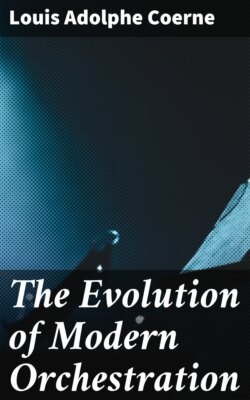Читать книгу The Evolution of Modern Orchestration - Louis Adolphe Coerne - Страница 19
V.
ОглавлениеThe evolution of instruments of percussion requires but brief mention. Sound-producing apparatus devoid of definite pitch belongs to the initial attempts of primitive men to assist vocal expression of emotional feeling, to accompany religious orgies, or to encourage their warriors on the march. The modern orchestra includes the best of these primitive species, transformed into perfected types of genuine artistic value, and has also drawn into requisition various instruments originating in countries that are far apart. Most commonly used are the bass-drum, the cymbals, and the triangle. The family of drums further includes the long side-drum and the small military drum. With the cymbals and triangle belong the tam-tam or Chinese gong, the Oriental and Spanish tambourine, the Spanish and Neapolitan castanets, and the Turkish crescent or bell-rattle. The use of all such instruments is, of course, the exception rather than the rule. Their mission is primarily to suggest "local" coloring or to emphasize rhythm for dancing.
Instruments of percussion possessing definite and variable pitch are represented primarily by the kettle-drums, which are constant and indispensable members of the orchestra. The early Hackbrett or dulcimer might also be classed under this heading, which further includes the various sets of bells, such as the carillon or Glockenspiel of Chinese origin, together with the Stahlspiel or Lyra, and the Xylophone.
This sketch demonstrates the fact that the early evolution of instruments went hand in hand with that of music in general and is subject to identical hypotheses. With the dawn of secular music, the development of instrumental construction and mechanism is focused upon the sixteenth century, with emphasis upon the anterior practice of employing complete homogeneous groups.
In order to cover the entire ground, this survey of the development of musical instruments has necessarily transgressed the bounds of the sixteenth century perspective. And since we are about to recontinue a critical review of the orchestra as inherited by Monteverde, it will be well to remember that in his day the only orchestral instruments in the modern sense of the word were violins and viols, harps, flutes, pommers, cornetti, trumpets, trombones. In combination with these, lutes, guitars, organs, the clavichord and the harpsichord were still employed.
